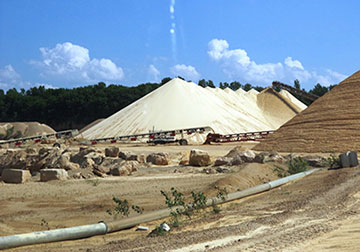Overview of nonmetallic mining in Wisconsin
The DNR Nonmetallic Mining Program works to ensure local and county governments and mine operators across the state follow standards for mine reclamation and provides assistance in developing mine reclamation plans and using a variety of materials in reclamation. The DNR's Air and Water programs also work with nonmetallic mining operations to issue permits and ensure the mining sites are complying with state wastewater, storm water runoff and air emissions standards.
Counties and local governments have responsibility for siting nonmetallic mines through existing zoning processes and for regulating mine operation. The DNR is not involved in the mine siting process and does not maintain a comprehensive list of current nonmetallic mines in the state.
Nonmetallic mining overview
Nonmetallic mining is the extraction of stone, sand, rock or similar materials from natural deposits. The most common examples of nonmetallic mines are quarries and pits. Nonmetallic mining is a widespread activity in Wisconsin. The variety of geologic environments support a diverse industry. An estimated 2,500 mines provide:
- aggregate for construction;
- gravel and crushed stone (limestone and dolomite) for road construction;
- dimension stone for monuments;
- volcanic andesite for shingles;
- peat for horticulture and landscaping;
- industrial sand for export out of state for the oil industry; and
- a considerable variety of materials for other uses.
Nonmetallic mining does not include extraction of metallic mineral deposits containing metals such as copper, lead or zinc. For more information on these types of mining, see metallic mining and ferrous (iron) mining.
Who regulates nonmetallic mining in Wisconsin
County and local zoning bodies are responsible for all mine siting requirements and regulations. County and local governments are also responsible for regulating mine operations other than reclamation activities. The DNR Storm Water Management Program may require mine operations to have Wisconsin Pollution Discharge Elimination System (WPDES) permits. Some mining operations will need to obtain air permits from the DNR Air Management Program as well.
Under ch. NR 135, Wis. Adm. Code, the DNR Nonmetallic Mining Program is responsible for ensuring uniform statewide implementation of nonmetallic mining reclamation requirements. It does this by overseeing county and local reclamation programs, known as regulatory authorities (RAs). The DNR provides technical assistance to these programs and audits them periodically to ensure they are administering reclamation programs in a uniform and reasonable manner across the state. A stakeholder group, the Nonmetallic Mining Advisory Committee, advises the DNR on its administration of the statewide reclamation program.
- Information for mine operators
- Information for Regulatory Authorities
- Mine reclamation requirements
- Industrial sand mining
- Local zoning information:

